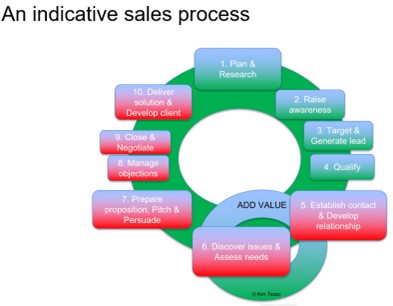
We were joined by delegates from legal, accountancy and consultancy firms for PM Forum’s “Cross-selling and referrer management accelerator” workshop earlier in March. A summary of delegate discussion topics and poll results are shown below to add to the learning resources from the session. While we discussed various tools and methods to promote cross-selling and referral management, a key theme emerged around changing culture. This included improving internal communication and collaboration as well as motivation to devote time to internal and external referrals: cultivate a cross-selling culture.
Change the organizational culture
A common thread was that fee-earners have a predominantly inward focus (e.g. What do I want? What can I tell people about my services?) rather than a outward focus (e.g. What do clients/referrers need? What will clients/referrers be interested in?).
To complicate matters, the structure of many firms means people operate in silos. And incentive and reward systems drive attention on short term sales rather than long term relationships.
As well as an attitude shift, cross-selling and referrer management require skills to learn about, talk to and forge relationships with internal colleagues and external referrers.
There are various tools to support organizational culture change including:
- Handy’s cultural types: Power, task, person and role Charles Handy Model of Organization Culture (managementstudyguide.com)
- Johnson & Scholes cultural web: Stories, symbols, power structures, organizational structures, control systems, rituals and routines The Cultural Web – Aligning Your Organization’s Culture With Strategy (mindtools.com)
- The McKinsey 7S framework from “In search of Excellence”: Shared values, Style, Skills, Systems, Structure, Staff, Strategy Enduring Ideas: The 7-S Framework | McKinsey
- Lewin’s 3 stage model of change (Unfreeze, Change, Refreeze) Lewin’s 3-Stage Model of Change Theory: Overview (whatfix.com) and Force Field Analysis Lewin’s Force Field Analysis Explained (change-management-coach.com)
- Kotter’s eight step change framework The 8-Step Process for Leading Change | Dr. John Kotter (kotterinc.com)
- Eight strategies to change your company culture (Drs Kevin and Jackie Frieberg) 8 Strategies to Successfully Change Your Company Culture | LinkedIn
Related posts on organizational culture
Changing behaviour in the workplace to boost productivity – psychology (kimtasso.com) December 2019
Leadership: Authenticity, values and culture – an overview (kimtasso.com) August 2019
Change management – Change Catalyst book review by Kim Tasso September 2018
A-E of cultivating a culture of relationship management (kimtasso.com) July 2010
Other cross-selling issues raised
Integrate cross-selling and referral management into other programmes
Marketing and business development (M&BD) teams can help guard against too many separate firm-wide projects that may confuse or defer fee-earners. One way is to embed the right cross-selling and referrer management attitudes and behaviours into other programmes – for example, into campaigns, content management, networking and Key Account Management (KAM). Another cultural shift.
M&BD supports effective internal communication and intelligence and knowledge sharing. Internal communication – Why, how and what (kimtasso.com). Most recognise the important communication, cross-fertilisation and collaboration role of M&BD in promoting a different culture.
This book looks at the strategic impact of internal communications Book review: Influential Internal Communication by Jenni Field (kimtasso.com). And a key theme is on culture change.
Manage the scope of cross-selling and referrer management programmes
Many cross-selling and referrer management programmes fail to get off the ground or maintain momentum because they are too ambitious or too general in scope. They need to be focused. This can be achieved in a number of ways depending on the culture and predominant ways of working within a firm:
- Appoint a senior cross-selling or referrer management champion to drive discussion and action and be accountable
- Select one client or referrer and learn from the experience. Share the success story.
- Develop a pilot with a small number of fee-earners and/or clients and referrers
- Be specific with the objectives to maintain a laser focus on what is to be achieved
- Set up a cross-selling or referrer management “hit team” to tackle specific organisations or internal teams
- Split the programme into discrete phases e.g. data analysis, strategy option discussions, information management
- Be agile and split the programme into separate sprints with specific outcomes where the next stage isn’t defined until the prior stage is complete
Does the partnership model support or thwart cross-selling?
A delegate raised an interesting question about whether the partnership structure and culture supports or thwarts cross-selling.
The answer depends on the nature of the partnership model. For example, some partnerships have a single profit pool and partners are rewarded on a lock-step basis (broadly this means that their rewards are linked to their length of time as a partner). This would engender a “one firm” approach where clients are considered owned by the firm. Cross-selling should flourish in this environment. Conversely, if a partnership is structured where rewards are allocated on a divisional or individual “eat what you kill” basis then there might be silos and client protectionism that is a barrier to cross-selling.
The professional rules requiring fee-earners to act in the client’s best interests may also have an impact on cross-selling (see, for example: solicitors to sell – cross-selling and professional standards (kimtasso.com))
How do you calculate share of wallet in professional services?
During the discussion on setting goals and SMART objectives there was a question about how to calculate the share of wallet for professional services clients and referrers. Professional services marketing has grown from a “dearth of data” culture although more firms are increasing their data capabilities and are becoming more data-driven.
As few organisations publish a detailed breakdown of their spend on professional advisers this is often an art rather than a science – with educated estimates dominating. Some ideas:
- If there is a close relationship, you can ask the client for their spend breakdown between their major providers. You might also explore whether the split is by design or accident and whether they consciously try to allocate spend across a preferred number of providers
- Some published financial accounts will show overall spend on different types of professional adviser and you can estimate your proportion from those figures
- There might be indicators of spend from other sources – such as legal directories, case studies or testimonials
- Where organisations have recently put their work out to tender, the invitation documents may indicate the overall spend and “packets” of work in each technical and geographic area
- You can monitor news and social media releases to assess the overall number of major transactions and the strength of relationships with different providers
- A few of the largest firms have internal management information systems that allow their own data to be tracked and use predictive analytics to estimate spend with other providers.
- Roundtables organised by third parties (e.g. the legal media) may bring together senior buyers who share their information on their spending habits and plans
Share of Wallet: What It Is and How to Calculate It (hubspot.com)
Customer Loyalty Isn’t Enough. Grow Your Share of Wallet (hbr.org)
How Industrials Can Capture More Share of Customer Wallet (lek.com)
Should you use a client charter?
One delegate said that their client charter enhanced the client-centred culture, client experience and supported cross-selling. Some examples to consider:
Client Charter – Gardner Leader Solicitors (gardner-leader.co.uk)
Client Charter | Standard of Service | FBC Manby Bowdler (fbcmb.co.uk)
Client Service Charter – Warner Goodman LLP
Our client charter | Herbert Smith Freehills | Global law firm
Client Charter : Elman Wall Limited, London
Client charter – Our commitment to excellent service | Kreston Reeves
Deloitte accredited by the Good Business Charter
Others mentioned the role of onboarding processes to promote cross-selling.
Delegate views
Delegate aims
- Internal referrals (cross-selling)
- One key takeaway I’d like from today is methods to cross-sell
- Find out more about cross selling culture, empowering people to do it and logging/reporting referrals
- Embed cross-referring into the firm’s DNA
- Building it into our key account management programme
- Encourage and deliver a better way of communicating across sectors and teams to identify opportunities
- Increase the internal referral culture
- Keen to encourage a two-way referral relationship between the LLP and subsidiary brands
- External referrals
- Learn how other firms approach their referrer relationships, challenge for us is developing a joined-up approach and avoiding pockets of knowledge within various teams/sectors, as well as engagement with our CRM system to record activity and referrals effectively
- Develop relationships with referrers when multiple people have relationships in the firm and don’t communicate
- Looking to develop more formal approach to referral management as part of a wider CRM project
- Referrer relationships seem to be managed in silos and by the individuals that own the relationship
- Have a programme run by fee earners, need to ensure we can help them to do more / provide value to referrers as we often look at things from our perspective and not theirs
- Other
- Here for a refresher. New to this firm. Have completed a BD Audit I would like to improve our cross-selling and referrer relationship management
Raised by delegates during exercises
- Cross-selling
- Address the gap between M&BD and fee earning teams on client and contact relationships
- Identify a small target group of individuals who are more receptive to the concept of referring
- Set SMART objectives (noting that short-term focus is driven by incentives)
- Economists find NPS problematic but client listening is a really good drum to beat
- Determine what clients would find helpful – listen to needs
- Some clients like to separate their business and personal lives and use different firms for each type of work – so a possible segmentation/categorisation issue to address
- Work with fee-earners to create a strategy and prove the concept, before rolling out more widely
- Ensure fee earners are trained on CRM and capturing the correct data. If the data isn’t being captured correctly (e.g. source reporting) then it is hard to measure the referrals. This will also have an impact on SMART objectives
- Referrer management
- Need for vision to underpin culture change
- Identify key referrers by current/future value
- Set SMART objectives (e.g. share of wallet)
- Identify relationship managers and ensure they are given time or rewarded to invest in relationships – Need the right people with the right expertise
- Map services to what the other firm offers
- Some sectors suit team to team relationship building
- Challenge long-standing relationships and associated risks
- Proposition needs to be clear – Have a specific proposition for each target
- Understand expectations on reciprocity – valued in different ways
- Accept long term game versus short term wins
- Need to invest in programme for medium-long term
- Buy-in and culture to making plans achievable
Delegate key takeaways
- Think about the best order to tackle things
- Cross-selling – the big questions
- The importance of specific goals to help motivate and manage expectations
- Follow a data driven approach – use this to set goals and measure successes
- Set clear objectives from the start to get buy-in from a large group (everyone has a responsibility and a part to play)
- Adopt a tiered approach to referrers
- Ensure solid foundations before going for the “glamourous” goals/aims
- Make sure we can capture data well before we start to design and implement a referrer or cross-selling programme
- Put structure around our approach – identify key areas and use contact mapping
- Obtain benchmark data and maintain data accuracy
- Recognise that research is key
- Need a compelling and engaging plan to gain commitment from fee earners
- Build into existing client programmes
- Use referral profiling exercise
- Upskill who does what in the firm, give fee-earners confidence to ask questions they may not know the answer too
- Importance of good research or access to information to underpin decision making
- In the short-term, capture the information and share internally
- Longer term, ‘portfolio management’ and contact mapping or evaluating relationships would be really valuable.
- Remember face-to-face significantly more effective with existing client referrals
- Link cross referral approach into KAM programme
- Use some of the tools from today as a way to invite the M&BD team into the ad hoc / currently not delivering programme that exists just now
- Understand that the diamond model is key – Measurable actions (i.e. multi-level representation) to move from bow tie to diamond model (hence increasing firmwide relationships as opposed to individual-based KAM Basics – Bowties and Diamonds (kimtasso.com)
- Link cross-selling sales to the client onboarding process.
- Useful to hear the different ideas and challenges to set up a more formal client cross selling / referrer process
- Some good ideas on tools that our teams can use formalise their networking and referral efforts.
Delegate poll results
Which aspect of the programme is of most interest?
- 25% Strategy and planning referrer programmes
- 41% Referrals from existing clients and cross-selling
- 35% Referrals from external referrers and intermediaries
Do you have a plan for referrer management?
- 6% Yes, and it’s good
- 29% Yes – but it’s not being used/implemented
- 6% Yes – but only M&BD use it
- 29% Yes – but it’ only for a few key referrers
- 29% No
Are your referrer management aims and plans?
- 29% At a firm wide level
- 18% For a particular market or segment
- 6% For a particular territory or office
- 6% For a particular service line
- 41% A combination
Do you have clear goals (and ROI measures) for your referrer management plans?
- 6% Yes
- 59% No
- 24% Sort of
- 12% It’s complicated
How would you rate your information systems for supporting referral management?
- 0% Excellent
- 25% Very good
- 31% Average
- 31% Poor
- 13% Non-existent
Which of the following methos do you use to promote internal referrals?
- 63% Client relation management targeting activities
- 56% Internal communications campaigns
- 56% Service line campaigns
- 56% Key Account Management (KAM)
- 50% Client satisfaction/listening reviews
- 25% Matric management (ie sector approach)
- 19% Client workshops
- 13% Recognition and reward systems
What do you perceive as the biggest barrier to cross-selling at your firm?
- 29% Lack of time
- 24% Lack of knowledge/distrust of other teams
- 18% No reward or incentive
- 18% Other
- 12% Fear/risk and protectionism
- 0% Lack of information (check notes)
Which methods does your firm use to promote cross-selling?
- 73% Key client analysis and plans
- 47% Internal knowledge systems
- 47% Internal campaigns
- 40% Cross-selling training
- 33% Relationship mapping
- 33% NPS and client listening programmes
- 20% Onboarding process
- 20% Workflow and referrals analysis
- 0% Automated prompting of gaps/opportunities
- 0% Client grading systems
Which external referrers does your firm target?
- 88% Banks, financial institutions and IFAs
- 76% Accountancy firms
- 59% Private equity/corporate finance
- 53% Law firms
- 35% Insolvency firms
- 29% Property firms
- 18% Charities and associations
- 18% Other (surveyors)
- 12% Regulators
- 12% Government and local authorities
Which methods does your firm use for generating more work from external referrers?
- 82% One-on-one or team meetings
- 76% Joint client events
- 71% Providing articles and speakers
- 65% Joint webinars
- 29% Collaborative/joint services
- 24% Dedicated plans for specific referrer organisations
- 24% Campaigns
- 18% Targeted mailings
- 18% Targeted social media
Related posts
Referrer and Intermediary Management – Silos, Targets and Culture (kimtasso.com) February 2023
Referrer Management Strategies – Rationale and Challenges (kimtasso.com) January 2023
Referrer Management workshop (June 2022) (kimtasso.com) June 2022
Cross-selling and referrer management – Expectations, Data and Focus (kimtasso.com) March 2022
Referrals – The role of internal communications (kimtasso.com) December 2021
Three referrer management themes – Plans, Relationships (kimtasso.com) July 2021
Referrer Management and Cross-Selling Insights (March 2021) (kimtasso.com) March 2021
Highlights from a referrer management workshop (2020) (kimtasso.com) December 2020
Six themes on cross-selling and referrer management workshop highlights (kimtasso.com) September 2020
pragmatic steps to improved referrer management 2019 (kimtasso.com) December 2019
A personal approach to cross-selling – outbound and inbound internal referrals (kimtasso.com) August 2018
Relationship and referrer management (kimtasso.com) December 2017
Cross-selling – The Big Questions (kimtasso.com) March 2017
There was also an article by Dominic Ayres in the January 2023 edition of PM Magazine entitled “The most effective cross-selling strategies your firm can use in 2023 to retain and grow clients”. His key points were:
- Know the client’s business – and tailor services and messages accordingly
- Expand who you know across the relationship
- Build complementary services
- Help clients see around the corner
- Engage and follow through with the opportunity







